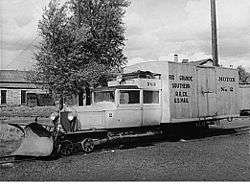Doodlebug (rail car)
| ”Doodlebug” | |
|---|---|
 East Broad Top No. M1, a narrow gauge gas-electric doodlebug that was constructed by EBT from a Brill manufactured kit | |
| Manufacturer | various, including EMC/Pullman, Brill/Mack, McKeen Motor Car Company, Rio Grande Southern Railroad |
| Specifications | |
| Car body construction | Coach/baggage combine |
| Prime mover(s) | various (gasoline, diesel) |
| Transmission | various (mechanical, electric, hydraulic) |
| AAR wheel arrangement | usually B-2 |
| Track gauge | 4 ft 8 1⁄2 in (1,435 mm) and 3 ft (914 mm) |
In the United States, doodlebug or hoodlebug is a name for a type of self-propelled railcar most commonly configured with both a passenger and freight compartment. Early models were usually powered by a gasoline engine, with either a mechanical drive train or a generator providing electricity to traction motors ("gas-electrics"). After a number of years of service, it was common for Doodlebugs to be repowered with a diesel engine.
Doodlebugs sometimes pulled an unpowered trailer car, but were more often used singly. They were popular with some railroads during the first part of the 20th century to provide passenger and mail service on lightly used branch lines, obviating the need to operate conventional trains consisting of a locomotive and coaches. Several railroads, mostly small regional and local networks, provided their main passenger services through doodlebugs in a cost cutting effort.
History
The new technology of gasoline engines led railroads to seek it as a higher efficiency alternative to steam power for branch line services. The McKeen railmotor was a line of gasoline-driven railcars produced between 1905 and 1917. The success of these early efforts was limited by the unreliability of their mechanical drive systems and the limited power available from early gasoline engines. Electric trolley cars were preferred for interurban service. The petroleum-electric drive control system invented in 1914 by Hermann Lemp, an engineer with General Electric, became the technological foundation of self-propelled gasoline railcars in the 1920s. In 1923 the Electro-Motive Company began production of self-propelled railcars, subcontracting bodies to the St. Louis Car Company, prime movers to the Winton Engine Company, and electrical equipment to General Electric. The Pullman Company was subsequently added as a subcontractor for car bodies. Production of self-propelled railcars dropped off with the onset of the Great Depression, which affected the market for branch line services severely.
Improvements to railcars were sought by The Pullman Company, who experimented with lightweight designs in partnership with the Ford Motor Company in 1925, then enlisted the services of pioneering all-metal aircraft designer William Bushnell Stout in 1931 to adapt airplane fuselage design concepts to railcars.[1] In 1931 the Budd Company entered a partnership with the French tire company Michelin to produce lightweight stainless steel Budd-Michelin railcars in the US. Those advances in lightweight railcar design were an important step in the development of the lightweight Diesel-electric streamliners of the 1930s.
Self-propelled railcar production was revived in 1949 with introduction of the Budd Rail Diesel Car.


See also
References
- ↑ Solomon, Brian (2015). Streamliners: Locomotives and Trains in the Age of Speed and Style, p. 32-33.
- Dorin, Patrick C. (1972). Chicago and North Western Power. Burbank, California: Superior Publishing. pp. 182, 188. ISBN 0-87564-715-4.
Further reading
- Edmund Keilty (September 1979). Interurbans without wires: the rail motorcar in the United States. Interurbans. ISBN 978-0-916374-38-9.
- Edmund Keilty (September 1982). Doodlebug country: the rail motorcar on the Class 1 railroads of the United States. Interurban Press. ISBN 978-0-916374-50-1.
- Edmund Keilty (December 1988). The Short Line Doodlebug: Galloping Geese and Other Rail Critters. Interurban Press. ISBN 978-0-916374-77-8.
External links
- Doodlebugs at american-rails.com. Retrieved October 10, 2012
- Doodlebugs in Jacksonville, Florida http://www.jaxhistory.com/Jacksonville%20Story/Picture%20of%20Jax%20Train,%20Doodlebug.htm